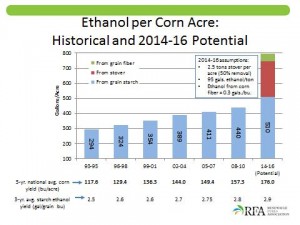In the third installation of RFA Vice President of Research, Geoff Cooper’s series on ethanol plant improvements, he highlights how improvements in farming practices and ethanol efficiency have allowed greater productivity and cost efficiencies. He explained that in 2008-2010, the ethanol industry was producing nearly 440 gallons of ethanol per acre, a 50 percent improvement over the average from just 15 years earlier. He continued by noting that future projections, which include the use of cellulosic ethanol such as producing fuel from corn stover and corn cobs, plus corn could approach 800 gallons of ethanol per acre.
 So how else have these efficiencies improved the ethanol industry? They have directly contributed to ethanol ability’s to lower greenhouse gas emissions (GHG) from gasoline on a well-to-wheels basis (or better known as lifecycle analysis), explained Cooper. He said that six recent reports show that corn ethanol reduced GHG’s by 28-53 percent using current technologies. He continues by highlighting that GHG reductions will continue to improve as technology improves.
So how else have these efficiencies improved the ethanol industry? They have directly contributed to ethanol ability’s to lower greenhouse gas emissions (GHG) from gasoline on a well-to-wheels basis (or better known as lifecycle analysis), explained Cooper. He said that six recent reports show that corn ethanol reduced GHG’s by 28-53 percent using current technologies. He continues by highlighting that GHG reductions will continue to improve as technology improves.
Simultaneously, GHG emissions are getting worse for the oil industry. This is due to the fact that oil is getting harder to extract and oil shale and tar sand technologies create more emissions than predecessor technologies.
Cooper concluded by saying that both American farmers and ethanol producers are investing in technology that will continue to lower their carbon footprint while at the same time producing more food, feed and fiber than ever before with less resources.

